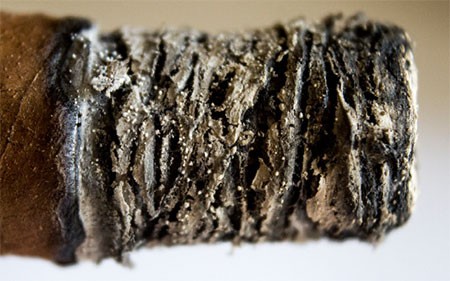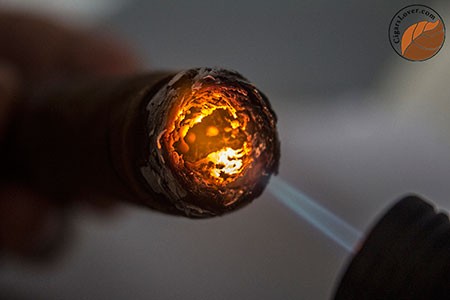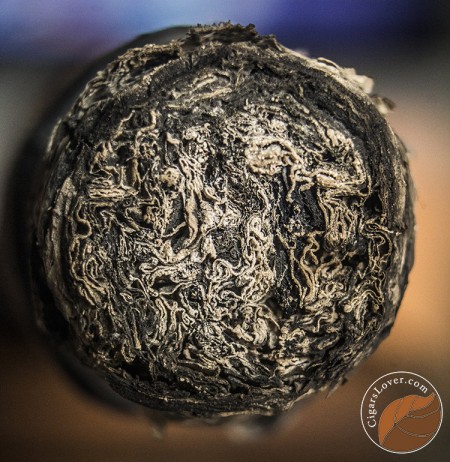During the last couple of months, we’ve posted two excellent articles originally published in an Italian cigar magazine called CigarsLover: “The Bands: the Whole Colour of Tobacco” and “Lighting a Cigar: the Method of Jacques Puisais”. Another issue of the magazine was recently released (download it here – there’s even an article written by yours truly!) and we’re back with another featured article, written by Didier Houvenaghel, that covers the cigar ash and its different aspects.
The white spots that sometimes appear on the ash
Those white spots show that the burn is more complete in those particular areas. That means that, for some reason, the combustion is either improved in those spots or worsened around them.

Two reasons may explain possible origin(s) of the phenomenon: originating from either outside or inside the wrapper leaf. In other words, we could assume that the manifestation of white spots on the wrapper during its combustion is due to an external contact or to a systemic source.
- EXTERNAL CONTACT HYPOTHESIS – Some cigars are treated externally with various products to improve the color of the wrapper (tone and homogeneity) and to boost the smell and taste of the cigar (additives). As those modified cigars should not be considered belonging to the premium family, let’s move on and only discuss genuine and quality cigars.
- SYSTEMIC HYPOTHESIS – We have to look at what is happening inside the leaf during its combustion. It thus involves its chemical components. The burning process being a complex dynamic system, it is difficult to isolate a specific organic element that would explain and justify the appearance of white spots after the combustion of the cigar. The intrinsic composition of a cigar leaf is relatively stable but does vary depending on the area considered in the same leaf. Vegetal tissues do indeed vary in content and structure if we consider the stem, the central, the lateral areas, the tip, or the rear of the leaf. So yes there are differences in composition but are they important enough to justify – after the huge composition modification due to fermentation – differences in the ash color, and even more importantly, the appearance of white spots? I do not think so.
Generally, when present, those white spots are evenly distributed over the surface of the ash and they are not constrained within some delimited areas. Possible reasons should be associated to the leaf chemical composition, and especially elements that are in stable concentrations throughout the tissues of the plant. In case of uneven distribution of spots, the origin is probably linked to the leaf structure and its naturally or artificially caused heterogeneity. But then the areas with spots would be clearly delimitated.
Inspector’s note: I did some research on this subject a while ago and it seems like the Magnesium is the chemical element that results in these white spots.
The “boiling ash” during the relightning of the cigar

This effect of ‘boiling’ the remaining oils of the leaves during the relighting of a cigar tends to happen generally when the cigar has had a bad burn in the first place. Consequently it occurs more often when ashes are black or dark grey. The phenomenon does not develop so often on cigars showing good combustion and white to grey ashes. On a cigar with an average to bad combustion, ashes are not pure and still have significant quantities of unburnt organic fraction. Those residues give the darker color to the ashes, and they translate an excessive presence of biological compounds in the burnt material.
When the lighter’s flame touches the ashes with its higher temperature, the remaining organic fraction is then immediately and powerfully burned. This activation of the burning is sometimes so extreme that ashes might seem to boil. When it occurs gently the resulting residue is sometimes showing whiter color than the original ash. After a few minutes the taster can observe the trace of that in form of lighter layers in the ash body corresponding to the moment of the cigar relighting.
The phenomenon of structural recombination – that I called ‘the boiling’ – is due to the fact that the temperature of the lighter (around 800-1400 degrees Celsius) is much higher than the temperature of the cigar combustion (around 600 degrees Celsius). This causes the structure of the ash to be shocked by this temperature increase and thus suffer a recombination and structural change. This phenomenon is more observable when a strong flame is used (torch lighter) than with a milder flame (regular lighter or match).


Nice to be able to learn more about cigars and tips about the craft! Thx..